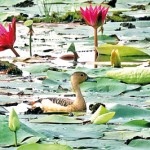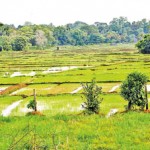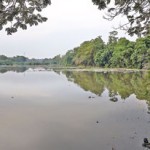News
Proposed elevated highway: Residents urge bypass to prevent wetland’s downfall
Around 200 residents, including farmers who will be affected by the proposed four-lane elevated highway from Rajagiriya to Athurugiriya, have directly appealed to President Gotabaya Rajapaksa to consider a different route.
The 10.4km highway stretch is the second phase of a 17.3km project from the New Kelani Bridge in Orugodawatte to Athurugiriya. Contentiously, 3.15kms of road crosses the Averihena Tank and surrounding paddy fields which are part of the Thalangama wetland.
These are two of the few green areas now left in Greater Colombo, the residents said in a letter sent to President Rajapaksa this week. There is evidence to show that, even if properly built, wetlands adjacent to roads and highways, even elevated ones, “slowly disappear due to reasons such as toxic emissions and noise”.
In June, former Environment Ministry Secretary A. H. Sarath Wijesinghe wrote to Highways Ministry Secretary R. W. R. Pemasiri saying the wetland — home to birds, reptiles, mammals, fish and insects, including threatened species — was under threat from the proposed highway.
Mr Wijesinghe asked for a reassessment of the proposed route and for alternatives to be considered “giving due attention to the environmental cost in order to achieve a win-win situation between road construction and environmental conservation”.
The affected wetland plays a significant role in flood control, particularly around Parliament; is valued for its scenic beauty; and is important for agriculture, fisheries, recreation, research and education, the Environment Ministry also held. It was also an integral part of the Colombo wetlands, identified in 2018 to be South Asia’s only Wetland City under the Ramsar Convention.
Since 2007, Averihena Tank and its surroundings are gazetted as an Environmental Protection Area (EPA) under the National Environmental Act owing to its “ecological, hydrological and historical importance”.
“Construction of an elevated highway on columns over this important wetland will certainly damage its biodiversity,” Mr Wijesinghe pointed out earlier this year. “It will also affect free flow of water in these flood sensitive areas. “In addition, construction of an elevated highway within the EPA is not a permitted activity under the National Environmental Act. Destruction of this wetland will have negative impacts on the international accreditation received as a Wetland City under the Ramsar Convention.”
The EPA permits only paddy cultivation, fishing, nature trails, bird observation towers, information centres, sales outlets and security posts in gazetted areas. Even these activities are subject to conditions.
The Central Environmental Authority (CEA) has not approved the mandatory Environmental Impact Assessment (EIA) for the highway. Its EIA division has in the past rejected the RDA’s position that the road would not cause much harm as it was on pillars.
But Anil Jasinghe, the new Environmental Ministry Secretary, indicated that it was not advisable to reject development project outright, particularly one that was “part of the overall traffic solution”. His Ministry and the Highways Ministry are holding talks on the best way forward, he said.
The Environment Ministry will, however, act within the provisions of the law, Dr Jasinghe insisted. The Cabinet and the Attorney General’s Department will provide guidance. There are no plans to de-gazette the Thalangama Wetland and take away its EPA status, he said.
Still, there are strong fears that this is being planned because of “high level interest” in the project, official sources said. “They may be hesitating at the moment but how else will they make such construction a permitted activity within an EPA?” a source asked. “It’s a joke. And the Environment Ministry says the matter is being further studied. What is there to study? It has to say ‘no’.”
The authorities have started surveying the area on the RDA’s instructions, including erecting stakes in paddy lands through which the highway is expected to run. Soil and water tests are also being done.
Residents still hope their plea to the President will have the desired effect. They have proposed “some alternative and less costly measures to mitigate traffic issues, instead of building elevated highways over the protected wetlands that would destroy its unique ecosystem”.
These include park-and-ride multi-modal transport centres for those entering the Colombo city; improvements to general public and rail transport systems, including metro rail systems; and imposition of heavy tariffs for private vehicular traffic entering the city of Colombo, thus acting as an incentive for public transport and traffic reduction.
If Colombo city and Port City were together developed as green areas, it would be a good marketing point when compared with Singapore, Dubai or Hong Kong which are congested with high-rise buildings and devoid of much greenery, the residents tell the President.
The Colombo Wetlands could be converted like the ‘Gardens by the Bay’ to become a mega tourist attraction with a difference “instead of being destroyed by elevated highways with its resulting impacts on the skylines, as also through emissions and pollution caused by heavy vehicular traffic”.
A final alternative would be to change the highway’s route to avoid the wetlands. This may seem more costly, they admit, but permanent loss to irreplaceable and limited environmental assets is unquantifiable. Pix by M.A Pushpakumara





